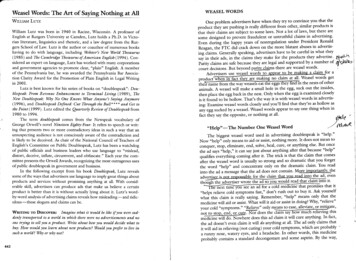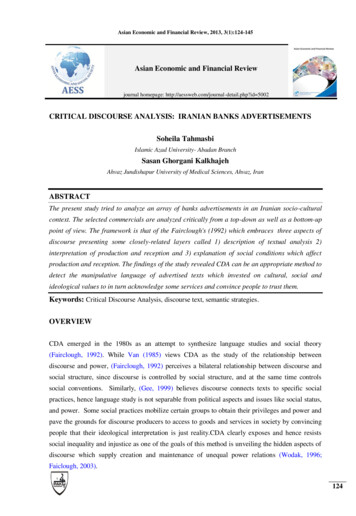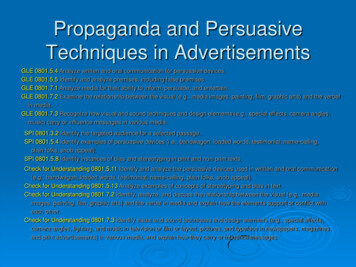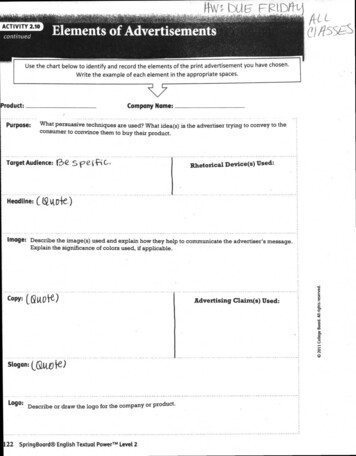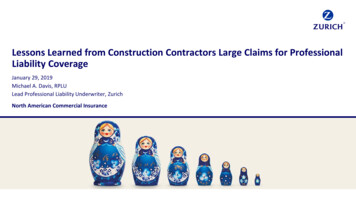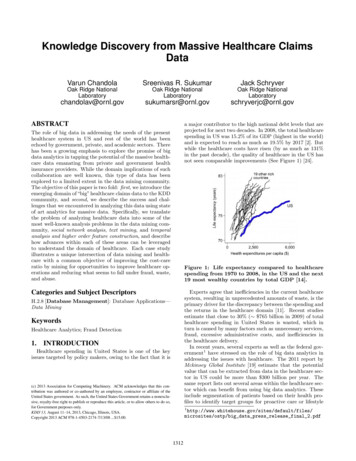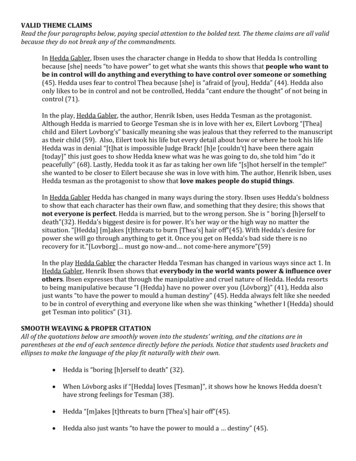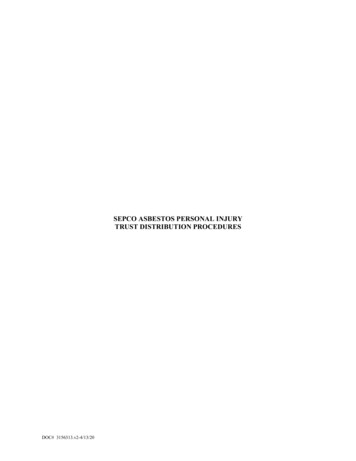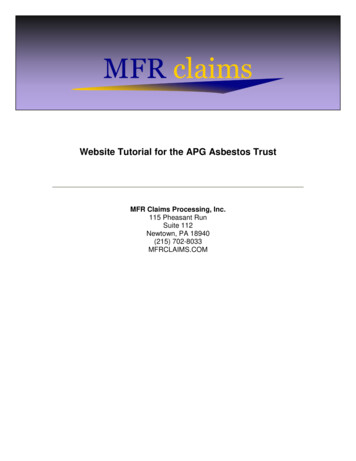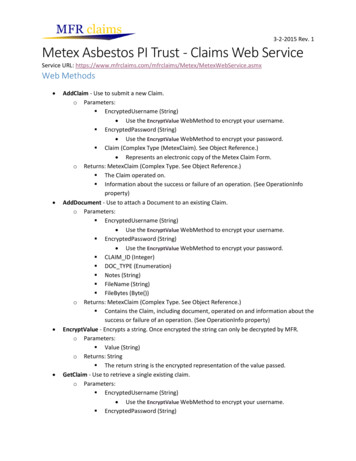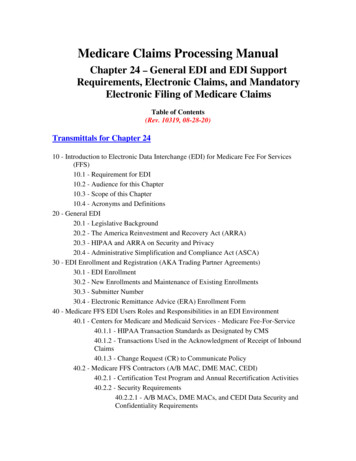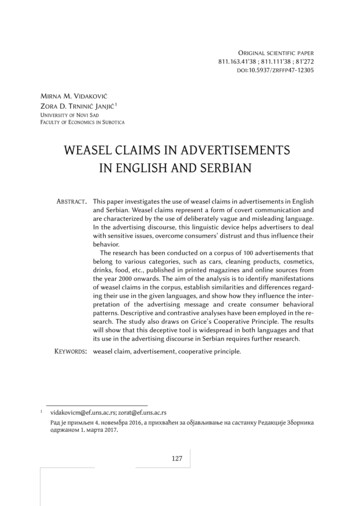
Transcription
ORIGINAL SCIENTIFIC PAPER811.163.41'38 ; 811.111'38 ; 81'272DOI:10.5937/ZRFFP47-12305MIRNA M. VIDAKOVIĆ,ZORA D. TRNINIĆ JANJIĆ1UNIVERSITY OF NOVI SADFACULTY OF ECONOMICS IN SUBOTICAWEASEL CLAIMS IN ADVERTISEMENTSIN ENGLISH AND SERBIANABSTRACT. This paper investigates the use of weasel claims in advertisements in Englishand Serbian. Weasel claims represent a form of covert communication andare characterized by the use of deliberately vague and misleading language.In the advertising discourse, this linguistic device helps advertisers to dealwith sensitive issues, overcome consumers’ distrust and thus influence theirbehavior.The research has been conducted on a corpus of 100 advertisements thatbelong to various categories, such as cars, cleaning products, cosmetics,drinks, food, etc., published in printed magazines and online sources fromthe year 2000 onwards. The aim of the analysis is to identify manifestationsof weasel claims in the corpus, establish similarities and differences regarding their use in the given languages, and show how they influence the interpretation of the advertising message and create consumer behavioralpatterns. Descriptive and contrastive analyses have been employed in the research. The study also draws on Grice’s Cooperative Principle. The resultswill show that this deceptive tool is widespread in both languages and thatits use in the advertising discourse in Serbian requires further research.KEYWORDS: weasel claim, advertisement, cooperative principle.1vidakovicm@ef.uns.ac.rs; zorat@ef.uns.ac.rsРа9 је @римљен 4. новемLра 2016, а @рихваћен за оLјављивање на сасOанку Ре9акције ЗLорникао9ржаном 1. марOа 2017.127
ЗБОРНИК РАДОВА ФИЛОЗОФСКОГ ФАКУЛТЕТА ХLVII (1)/2017INTRODUCTIONAdvertisements represent a form of public (addresses anonymousaudience), one way communication about goods, services, causes,ideas, organizations, etc., which is carried out through means suchas telephone, newspapers, magazines, radio, the Internet, etc., andwhose objective is “to change the thinking pattern (or buyingbehavior) of the recipient, so that he or she is persuaded to take theaction desired by the advertiser” (Advertisement, n.d., Vestergaardand Schroder, 1985, pp. 10, 13–14). In an attempt to attract a widerange of consumers and influence their buying behavior, advertisers employ a variety of linguistic strategies. A commonly usedstrategy is covert communication, which means that advertisersoften choose to convey their communicative intention withoutrevealing the informative one. According to Tanaka (1994, p. ix),“the distinction between the informative intention, the intention toinform the audience of something, and the communicative intention, that is, the intention to reveal this informative intention, iscrucial in accounting for covert communication”. In addition toinfluencing consumers’ buying behavior, covert communicationenables advertisers to deal with sensitive issues while “avoiding taking responsibility for the social consequences of certainimplications arising from advertisements” (Tanaka, 1994, p. 42).This linguistic strategy clearly violates the Cooperative Principlethat is generally assumed to govern communication (Grice, 1975;Yule, 1996). The Cooperative Principle, defined by Grice (1975, p. 45),states the following: “Make your conversational contribution suchas is required, at the stage at which it occurs, by the accepted purpose or direction of the talk exchange in which you are engaged”.This means that there is a generally accepted unstated assumptionamong the participants in interaction that their talk exchange isbased on truthful, clear and relevant utterances (Yule, 1996, p. 37).In Tanaka’s (1994, p. 21) opinion, Grice formulated this principle inorder “to make the important claim that the speaker tries to meetcertain standards in communication, and that the hearer uses thesestandards in deriving what the speaker intends to communicate”.Advertisers exploit this principle in order to influence consumers’interpretation of advertising messages and accomplish their goalsi.e. sell a product or a service.128MIRNA M. VIDAKOVIĆ, ZORA D. TRNINIĆ JANJIĆ
WEASEL CLAIMS IN ADVERTISEMENTS IN ENGLISH AND SERBIANThis paper investigates the use of weasel claims as a form of covertcommunication in advertisements in English and Serbian. The firstpart offers the theoretical framework, i.e. definition and descriptionof this phenomenon based on contemporary dictionaries of Englishlanguage, and literature that deals with advertising language andcovert communication (Larson, 2012; Myers, 1994; Rudinow andBarry, 2008; Schrank, 1988; Tanaka, 1994, etc.). The second part presents the results of the research that has been conducted on a corpusof 100 advertisements in English and Serbian, taken from printedand online sources, with the aim of illustrating various manifestations of weasel claims in the given languages and the ways in whichthey create consumer behavioral patterns. Finally, the paper brieflylooks into the application of Grice’s Cooperative Principle in advertisements from the corpus, with the aim of gaining more insight intothe process of interpreting weasel claims.WEASEL CLAIMS: DEFINITION AND ORIGINBoth Oxford Dictionary of English (2005) and Webster’s New EncyclopedicDictionary (1994) define weasel words or claims as a form of deliberately vague, ambiguous, or misleading speech. Oxford AdvancedLearner’s Encyclopedic Dictionary (1993) and Collins English Dictionary(1994) also provide information regarding their usage. According toOxford Advanced Learner’s Encyclopedic Dictionary (1993), weasel words“reduce the force of what one is saying” and are “used when onewishes to avoid committing oneself to a definite statement”, whileCollins English Dictionary (1994) states that such words or statementsare employed when a person wants “to avoid answering a questionclearly or to make someone believe something that is not true”.Schrank (1988) observes that weasel words initially “appear substantial”, but upon closer look, they “disintegrate into hollowmeaninglessness”. They frequently occur in written or spoken discourse characterized by persuasive nature, such as advertisementsand political speeches.The deceptive character of weasel claims is based on anaddressee’s inference that stems from his/her expectations associated with the conveyed message. Rudinow and Barry (2008, p. 317)state that when the addressee hears or reads a message that containsa weasel word, he/she tends to ignore it and focuses only on theclaim. For example, a lexeme help, one of the most frequently usedMIRNA M. VIDAKOVIĆ, ZORA D. TRNINIĆ JANJIĆ129
ЗБОРНИК РАДОВА ФИЛОЗОФСКОГ ФАКУЛТЕТА ХLVII (1)/2017weasel words in advertisements, is often found in phrases such as“helps stop, helps prevent, helps fight, helps overcome, helps you feel, helpsyou look”, i.e. advertised products help keep us young, help prevent cavities, help keep our houses germ-free and the like (Rudinow & Barry, 2008,p. 317). The lexeme help means aid, assist (Rudinow & Barry, 2008, p.317), and does not guarantee that the statement is true. However, therecipients of a message interpret helps stop as stop and helps prevent asprevent. This interpretation actually represents the desired result.Therefore, as Rudinow and Barry (2008, p. 317) point out, “once helpis used to quantify a claim, almost anything can be said after it”.Another frequently employed weasel word is virtually as in the slogan For virtually spotless dishes nothing beats Cascade. Although virtuallymeans almost, recipients of the message tend to infer the meaningthat the product leaves the dishes spotless. According to Larson(2012, p. 436), “if the product truly did the job it promises to do, theword virtually would be irrelevant”.Myers (1994, pp. 67–68), who investigated vague language inadvertisements, says that it is “worth distinguishing” ambiguity“from another indeterminate use of meaning, in which no definitemeanings can be pinned down”, and which is found in the use ofwords such as “quality, excellence, style, incomparable” and the like.He (1994, p. 68) notices that such lexemes are particularly common inadvertisements for luxury goods and services. Schrank (1988), on theother hand, associates them with advertisements for parity productsand concludes that “since no one superior product exists, advertising is used to create the illusion of superiority”. Therefore, it mightbe noted that weasel claims are widespread in the advertising discourse in general, which will also be confirmed by the research thatfollows.As far as the origin of the term is concerned, various sources suggest its relation to a weasel’s habit to suck out the content of the egg,without seemingly breaking the shell (Collins English Dictionary, 1994;Rudinow & Barry, 2008; Schrank, 1988; Weasel Word, n.d.; Webster’sNew Encyclopedic Dictionary, 1994). However, such weasel behaviorhas not been confirmed by scientists (Weasel Word, n.d.).According to The Phrase Finder (Weasel Words, n.d.), some ofShakespeare’s plays contain evidence which indicates that suchbelief existed in the past – in Henry V (1598) Shakespeare wrote: Theweazel Scot Comes sneaking, and so sucks the princoly egg, and As You LikeIt (1600), contains the following line: I can suck melancholy out of a song,as a weazel sucks eggs.130MIRNA M. VIDAKOVIĆ, ZORA D. TRNINIĆ JANJIĆ
WEASEL CLAIMS IN ADVERTISEMENTS IN ENGLISH AND SERBIANThe first recorded use of the term weasel word dates back to 1900,when it appeared in the article titled “Stained Glass Political Platform” by Stewart Chaplin, which was published in The CenturyIllustrated Magazine (Weasel Word, n.d.; Weasel Words, n.d.).THE RESEARCH: AIM AND METHODOLOGYThe research conducted in this paper is based on a corpus of 100advertisements in English and Serbian that belong to the followingcategories: cars, cleaning products, cosmetic products, drinks, food,etc., and that have been used in various printed and online sourcesfrom the year 2000 onwards. The advertisements in Serbian havebeen taken from magazines such as Esquire, Gloria IN, Harper’sBazar, Lisa, Men’s Health and a video-sharing website You Tube,while the advertisements in English have been found in magazinessuch as Glamour, Seventeen, the website Ads of the World, whichrepresents a huge database of advertisements from all over theworld, and You Tube. As far as the corpus in Serbian is concerned, itneeds to be mentioned that the advertisements which refer to foreign products or services often represent a translation that hassometimes undergone certain adaptations to a greater or lesserdegree, while the advertisements for the domestic products and services represent the original messages. This observation needs to betaken into account in the research, because it might affect theresults of the study.The aim of the analysis is to illustrate various manifestations ofweasel claims in both English and Serbian, compare their usage inthe given languages, and show how they covertly influence consumers’ interpretation of a message and direct their behavior towardsthe advertisers’ desired outcome (i.e. the purchase of a product or aservice). Therefore, descriptive and contrastive analyses have beenemployed in the research. The first method has been used todescribe, categorize and interpret weasel claims, which can shedlight on the ways this linguistic device creates consumer behavioralpatterns. This part of the research is based on the descriptions andclassifications offered in Larson (2012), Mallery (n.d.), Schrank (1988)and Vidaković (2008). It also briefly addresses Grice’s CooperativePrinciple (1975) with the aim of giving deeper insight into the interpretation of the advertising messages. Contrastive analysis has beenMIRNA M. VIDAKOVIĆ, ZORA D. TRNINIĆ JANJIĆ131
ЗБОРНИК РАДОВА ФИЛОЗОФСКОГ ФАКУЛТЕТА ХLVII (1)/2017used to draw similarities and/or differences with regard to the use ofweasel claims in English and Serbian.THE RESULTS OF THE RESEARCHA very frequent manifestation of weasel claims comes in a form ofunspecified comparison, where the element that should serve as abasis for comparison is left out. For example, when consumers readthe slogan Ford has a better idea, they do not know which other product the advertised car is being compared to, and therefore cannotmeasure the extent to which a certain feature has been improved,i.e. one cannot measure better, if the starting point i.e. good is notidentified or defined. Making comparison requires the existence ofa reference point which, in this case, is omitted, and the resultingstatement is not as informative as it should be. This phenomenon isillustrated by the examples taken from the corpus in English (examples 1– 8) and Serbian (examples 9–16).1)2)3)4)5)6)7)Skin looks younger, healthier, more radiant. (Glamour)Uplifting Results. Younger eyes in an instant. (Glamour)Stand out with a brighter, bolder designer smile. (Glamour)Rosier color. Creamier feel. (Glamour)For healthier looking skin. (Glamour)See brighter, smoother skin in just one week. (Glamour)Bigger. More powerful and ready for action.(https://www.youtube.com/watch?v gOImUeM36DA)8) Fast just got faster. (Ads of the World)9) Jače delovanje na bore i čvrstinu kože u mesec dana. (Gloria IN)10) Colgate Max White for Men. Za belje i sjajnije zube. (Men’s Health)11) Vozite dalje. Živite bolje. (Men’s Health)12) Mekana Lunarlon pena koja se nalazi u međuđonu učiniće da svaki tvojkontakt sa podlogom bude mekši i stabilniji. (Esquire)13) Muzika nikada nije bolje zvučala. (Esquire)14) Vode ovih karakteristika imaju bitnu ulogu u prevenciji i očuvanju zdravlja. One omogućavaju bolju hidrataciju organizma, na taj način se naše132MIRNA M. VIDAKOVIĆ, ZORA D. TRNINIĆ JANJIĆ
WEASEL CLAIMS IN ADVERTISEMENTS IN ENGLISH AND SERBIANtelo alkalizuje i neutrališe negativne produkte metabolizma. (Lepota izdravlje)15) DIS. Platićeš manje.(https://www.youtube.com/watch?v -wljynm -6Y)16) Traje 3x duže nego što ste očekivali.(https://www.youtube.com/watch?v 6HzbgKSOd4Q)The underlined examples show that unspecified comparison isused to reinforce the meaning of a message, i.e. to add the component of superiority to an advertised product. For example, the use ofadjectives rosier and creamier in Rosier color. Creamier feel. implies theimprovement in colour and feel of the advertised makeup, while further and better in the advertisement Vozite dalje. Živite bolje. (Eng.Drive further. Live better.) suggest that the Renault servicing andmaintenance office helps drivers enhance their driving experienceand thus improve their lives. General expectation regarding the useof comparative forms in advertisements (which require a basis forcomparison and imply the change for the better), as well as thebackground knowledge (consumers know that advertisers cannotcompare their products or services to the competitive ones explicitly) may eventually lead the consumers to think that the advertisedproduct (makeup) is a better choice compared to products of thesame category offered by other brands, while the consumers’ decision to have their car checked or serviced in the servicing and maintenance center is desirable, because it would not make sense todecline an offer that promises a better driving and living experience. However, at the same time, these messages are vague becausethere is no reference point which would inform the consumers ofthe extent to which the improvement has been or will be made (i.e.we cannot measure the improvement suggested by rosier, creamier,further and better) or which brand the given product is compared toso that the difference and benefits are made obvious. This phenomenon actually corresponds to the definition of weasel claims as a device used by communicators (advertisers in this case) to avoidcommitting themselves to making definite statements (Oxford Advanced Learner’s Encyclopedic Dictionary, 1993).Schrank (1988) observes that “the only time better can be used iswhen a product does indeed have superiority over other products inits category or when better is used to compare the product with someMIRNA M. VIDAKOVIĆ, ZORA D. TRNINIĆ JANJIĆ133
ЗБОРНИК РАДОВА ФИЛОЗОФСКОГ ФАКУЛТЕТА ХLVII (1)/2017thing other than competing brands. An orange juice could thereforeclaim to be better than a vitamin pill, or even the better breakfast drink”.He (1988) also highlights a specific use of the superlative form best. Inhis opinion, best should be interpreted as equal to in advertisements,i.e. “best means that the product is as good as the other superiorproducts in its category”. Therefore, the use of this superlative formin the advertisements Braid gives you the best protection at home andon-the-go. (Seventeen); Najbolji izbor za vaše dete. (Eng. The best choicefor your child.) (Lepota i zdravlje); Najbolje rešenje za vaš pod. (Eng. Thebest solution for your floor.) (Lepota i zdravlje) does not necessarilyguarantee that the advertised products are the best in their own category. This is particularly the case when the superlative form isaccompanied by a hedging device, which “indicates that what we aresaying may not be totally accurate” (Yule, 1996, p. 38). For example,in the advertisement Perhaps it’s not that strange that probably the bestair purifier in the world was created here (https://www.youtube.com/watch?v he0Kxis Z2Q&t 55s), the claim of superiority has beenexplicitly weakened by the hedge probably.Weasel claims are frequently manifested through the use of numbers in a prepositional phrase. Such use of weasel claims can bedetected in the following examples taken from the sources in English(examples 1–6) and Serbian (examples 7–10).1) Starting at 22,500. (Glamour)2) Mightiest protection for even the skin tightest. Up to 100% leak-free periods. (Glamour)3) Brighten, whiten, freshen, and save up to 30% per load. (Glamour)4) World's only body wash with fragrance touch technology. Touch your skinto release fine fragrance for up to 12 hours. (Glamour)5) Olay Total Effects fights 7 signs of aging. Reviving skin to look up to 10years younger in 4 weeks. (Glamour)6) The Tiguan. From only 24,999.(https://www.youtube.com/watch?v 8Z2q9o0kcaA)7) Pružite vašoj koži kvalitetnu negu i obezbedite joj svežinu i vitalnost u toku 24h. (Lisa)8) Banca Intesa: Do 48% niža kamata na revolving. Odloženo plaćanje do 45dana bez kamate. (Gloria IN)9) Super kaša sadrži i do 75% lako rastvorljivih ovsenih pahuljica. (Lepota izdravlje)134MIRNA M. VIDAKOVIĆ, ZORA D. TRNINIĆ JANJIĆ
WEASEL CLAIMS IN ADVERTISEMENTS IN ENGLISH AND SERBIAN10) Do 3x brže čišćenje masnoće.(https://www.youtube.com/watch?v vnyvIG13MtQ)The numbers accompanied by a preposition in the examples aboveconvey a vague idea of the actual benefit associated with the use ofthe advertised product or service. For example, the phrases up to100% and do 75% (Eng. up to 75%) refer to any value between 0% andthe stated percentage point (i.e. 100% and 75% respectively). Also,starting at and from just followed by a number (i.e. price) express anindefinite price range. Furthermore, u toku 24 sata (Eng. during 24hours) does not explicitly mean all day.However, consumers initially tend to read these claims in such away so as to reach the best possible interpretation, i.e. up to 100% isprobably interpreted as close to 100% or even 100%, which, however,is rarely true. Such interpretation actually reflects theirexpectations.In addition to the above mentioned examples, the same effect isachieved by the use of lexemes and phrases such as more, over, asmuch as, as little as, under, less than, etc. in English (Albrighton, 2010),or više od, preko, samo and the like in Serbian. According to Albrighton(2010), depending on the lexeme or expression used to provide avague numerical range, people will either overestimate or underestimate the value or quantity. Albrighton (2010) even gives an examplein which the combined use of up to and more sugg
This paper investigates the use of weasel claims in advertisements in English and Serbian. Weasel claims represent a form of covert communication and are characterized by the use of deliberately vague and misleading language. In the advertising discourse, this linguistic device helps advertisers to deal
